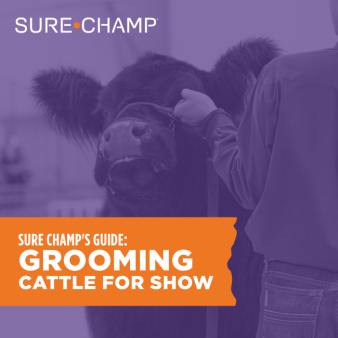
We’re not kidding around when we say the competition in the goat show ring has really heated up over the years. Young exhibitors from coast to coast have taken to Boer goats, and their popularity has grown significantly.
The young kids might appear cute and somewhat friendly; however, they take the same time, diligence and patience to calm down, break and prepare for the show ring as any other livestock species. Cooper Bounds, assistant livestock judging coach at Western Illinois University and owner of Bounds Show Goats at Good Hope, Illinois, offers his advice for breaking goats to make them look their best in the show ring.
- Getting Acquainted
After you’ve purchased your projects and gotten them to their new barn, Bounds said the most important thing is to get them settled, make sure they know what humans are and minimize their stress for the first week to 10 days. This is critical to their health and performance to make sure they don’t go backward, go off feed and water, and subsequently start losing weight.
He advises moving slow and quiet around the kids but getting in the pen with them, so they get used to your presence. Let them smell you, see you and hear you to get familiarized with you. The more you interact with them in their environment (their pen) that first week, the more familiar they are going to be with you and more comfortable they will be when it is time to work with them. It is all about establishing trust between the animal and the human.
“I will tell you those really, really good showmen that look like those goats will do just about anything for them; it’s because of the amount of time they spent with them. Not just on a chain or on the halter or on a stand, but also in the pen and interacting with them and creating a bond. They’re going to spend time with them in the pen. The goats are going to get kind of inquisitive and come up and mess with you. If you’re just dumping feed and filling the water bucket and taking off, they’re going to stay pretty crazy. So, you need to be able to spend a pretty tangible amount of time with them, so they get to know you,” Bounds said.
- Halter Breaking
Once you’ve got your new show goat acclimated to its new surroundings and the two of you are now friends, it is time for it to get used to the halter. Although goats are shown on chain, having them halter broke is the best way to lead and work with them. However, Bounds said halter breaking is misleading, as a goat doesn’t just “break” once it has a halter on.
The first step is to make sure the halter is on properly around the goat’s jaw and ears, so it is comfortable, and the animal won’t slip out of it. Next, get it used to the idea of a halter by tying it up. Tie its head up snug so it can’t look around, but still make it comfortable for the animal. And don’t leave your goat alone. This is another opportunity for your goat to get used to you. While it is tied, talk to it, stay calm and work picking up its legs and setting them square, so it gets used to standing in that position.
After about a week of daily tie-up sessions where the goat should be used to the halter, it is time to teach it to lead; for some goats this will come second nature, while others will need some added encouragement. Patience will be the biggest and most critical resource the exhibitor will need during this phase.
“Particularly with goats, the harder you try and place your will on them, the opposite is going to happen. So, we need to be able to have patience and act calm with them and let them know that it’s a team effort. We’re not going to just drag them around and expect them to trot along beside us. That doesn’t make any sense, and just like any relationship there’s got to be some give and take and a level of trust there, to where they can feel comfortable walking with you,” Bounds said. “That’s the biggest misnomer. A lot of times people think, ‘oh, we’re gonna put a halter on them, we’re gonna drag them and eventually they’re gonna break?’ I don’t know why they call it halter breaking, but I don’t really like that word.”
- Chain Breaking
Now that the goat is accustomed to walking on a halter comfortably, it is time to train it to walk with the chain that it will wear while being shown. Bounds said it is imperative to train your goat with the proper tools and to work with the more humane pronged chain instead of the flat dog chain that many national shows require. He said the flat chain is one of the more inhumane options out there as it chokes the goats more. He said many shows are trying to outlaw the pronged training collars because they appear cruel, but they actually are more comfortable for the animal.
“It’s not a spike. A spike is going to pierce and go through the skin. It is a blunt prong that is actually more humane than a flat chain. If you think about it, you have less surface area touching that goat’s neck and so that is not nearly as restrictive on their windpipe. It allows the goat to be more comfortable. They don’t want to try to get away from it as bad,” Bounds said.
When acclimating your goat to the chain, get it used to it on the standstill; then teach it to walk on the chain. Make sure to have it tight, right under the goat’s jaw. The chain helps with control, and once you teach your goat to walk, you can begin learning to set your goat square using the chain.
- Show Ring Ready
After weeks of hard work and preparation at home, you’re ready for competition. It’s time to hit the show ring. Bounds offers his best advice for show day.
Do:
- Keep the head up and nose pointed down.
- Keep your goat between you and the judge, switching sides as the judge moves.
- Keep a tight hold on the chain and step away from the goat and make sure the front feet are wide and square when the judge is in front of you.
- Learn to set your goat’s feet by pushing on the chain.
- Keep all four feet square at all times.
Don’t:
- Tilt the head too far back so the goat look looks uncomfortable and appears unnatural.
- Hard brace your goat during the entire class. A hard brace is only necessary for handling.
When it comes to bracing, one thing Bounds would like to emphasize is the importance of pushing into your animal to make it brace, rather than pulling on it to make it brace. By pushing into the chest instead of pulling on its neck, you will have less resistance and the goat will give you a harder brace.
“If a guy comes up, grabs you by the head and yanks you, are you going to try to walk towards that guy or run away from him? So, don’t pull would be the number one ‘don’t.’ You want to be able to give that animal surface area to drive against your side or drive against your leg. It’s a deal where the more you push the more the animal should push. It’s more of an art,” Bounds said.
Get acquainted. Get your goat comfortable on the halter and chain. Head out, nose down and push, don’t pull. That makes getting your goat show-ready sound straightforward. Take your time to follow the advice that came from a long-time showman and getting your goat ready for the show ring will be simple. Bounds reminds that getting to the ring, and ultimately the backdrop doesn’t happen overnight. Put in the time and effort, EVERY. DAY. on your journey to #preptowin.

